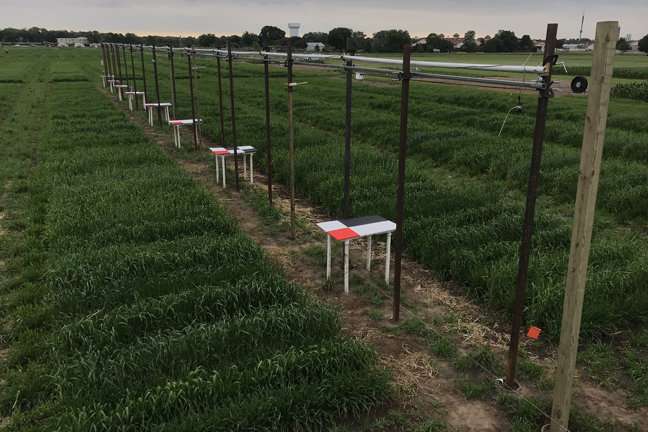Researchers develop DIY field imaging system

Farmers and plant breeders can now build their own automated field camera track system to collect data on dynamic plant traits, such as crop lodging and movement, as it's happening in the field to help reduce losses in crop yield.
A team of University of Minnesota researchers led by Alex Susko, doctoral candidate and member of the Precision Agriculture Center in CFANS, developed the system to capture videos of plant movement under very windy conditions as well as stem failure or lodging. Lodging occurs when a plant falls or bends over due to high winds, disease, wet soil, excess nitrogen in the soil, machinery, or animals and can lead to losses in crop yield.
"Field camera track systems exist, such as the PhenoSpex FieldScan, but it's proprietary and primarily designed for container crop phenotyping. Our system is open source, less expensive, and easier to construct," said Susko. "It's my hope that a system like this opens the possibility for the discovery of novel plant phenotypes."
The study's findings, published in the Hardware X Journal, expanded on work by Peter Marchetto, an assistant professor in the Department of Bioproducts and Biosystems Engineering, who used a camera across a field on parachute cord to take photos of lodging.
The U of M camera-tracking upgrade allows researchers to record real-time plant traits at different locations in the experimental field. This technology enables plant breeders to collect lodging data in real time, which will help improve the lodging resistance of cereals. The camera system captured lodging in approximately 15 minutes, saving hours of time as compared to measuring it manually, which can take three hours. Furthermore, this technology stretches the possibilities of high throughput phenotyping, and its open source nature will allow for further adaptation to grower and breeder data collection needs.
Researchers took hemispherical videos of crop movement at varying wind speeds at fixed locations and were able to quantify the movement using MATLAB. The study's results allowed them to distinguish the movement of two different oat varieties based on the frequency and magnitude of oscillating stem movements in the wind.
"Since we are interested in the plant response under wind stress, we can operate this system under very windy conditions to obtain videos of plant movement, a novel phenotype," said Susko. "I'm interested in how different physiological parameters such as plant height affect plant movement, and in turn, plant lodging resistance."
Researchers developed a specific camera track to photograph small grains under direct wind stress. The camera track system is made of commercial hardware and electronics accommodating 360-degree cameras. It can be adapted to various field dimensions, crops, and sensor systems to get high throughput phenotypic data unmeasurable by other systems.
"Existing methods to collect data on lodging, such as hand-grading or drone imaging, don't work for short-term events, and unmanned aerial vehicles are unstable during storms," said Marchetto. "This new system is specifically designed to withstand inclement weather, which is important for obtaining better data and addressing issues before they become losses in yield."
More information: Alexander Q. Susko et al, An automatable, field camera track system for phenotyping crop lodging and crop movement, HardwareX (2018). DOI: 10.1016/j.ohx.2018.e00029
Provided by University of Minnesota





















